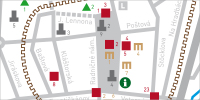|
                 
|
An important trait of Bardejov and the region of Upper Šariš lie in its diversity. The region, as very few others in Slovakia, was home to many different ethnicities and religions. The various ethno-religious groups left its mark onto the history, culture, language and architecture of the region.
The Upper Šariš area marks the historical border between Western and Eastern Europe. As such the region saw the interaction of various nations and cultures. Until present day the Slovaks co-habit the area with Ruthenian and Roma people. In the past the Germans, the Jews and the Poles were also present. The area also delimits western and eastern Christianity. One can find the members of Roman Catholic, Evangelical, and Orthodox as well as Greek Catholic church living side by side.
Commonly used languages in the past include German, Latin, biblical Czech, Yiddish, Hungarian as well as the Šariš Slovak, Ruthenian and Roma dialects. The preponderance of one language over others among the higher social classes varied from period to period. Naturally the languages also interacted with each other. This is best illustrated on the fact that in the Šariš dialect there are around 1500 words borrowed from German.
|
The medieval German element was crucial for the historical development of Bardejov. German language and culture dominated the town during the period of its greatest glory between the fourteenth and the sixteenth century. Bardejov was considered a German town (hence the historical german name “Bartfeld”). The German nobles and burghers owned almost all of the buildings and businesses outside the town’s walls.
As the German character of the city began to dwindle other nationalities took the leading role. In the eighteenth century the Hasidic Jews from Galicia (from areas of current Ukraine) contributed to the local cultural milieu. The importance of their community steadily increased until the 1930s. At the time the Jews amounted to one third of the Bardejov’s inhabitants and the Jews owned the majority of property in the town’s center.
The sacral architecture of the town was also marked by cultural diversity. One can find twelve Roman Catholic, three Greek Catholic, two Orthodox, one Evangelical and one Brethren church, as well as two synagogues. Wooden churches, structures built without the use of metal nuts, are also among the unique sights in the area. In the past there were more than 300 of such buildings. At present only 50 remain preserved. The area of Upper Šariš (the vicinity of Bardejov and Svidník) contain 26 of these buildings. A part of these are registered in the UNESCO World Heritage
|
The Jewish Suburbia and the town's historical core are also registered in the UNESCO list. The unique tradition of 500 years of tolerance for people of different national, cultural, linguistic and religious backgrounds was the main reason for the inclusion to the list. The peaceful cohabitation was violently interrupted by the World War II and the holocaust which saw the total annihilation of local Jewish community. The Holocaust Memorial, set up in 2014 near the vicinity of the Jewish Suburbia, still reminds us of this terrible event.
The period following the breakup of Austria-Hungary left several marks on local culture as well. Due to political development in the region Slovak became the dominant language. This change also brought a shift of the town’s name from the traditional “Bardijov” into modern Slovak “Bardejov”.
The influence of twentieth century communist ideology hand in hand with the annihilation or gradual assimilation of local ethno-cultural groups cost the town some of its multicultural character. Yet thankfully, intellectual as well as material heritage in the form of works of art, historical sights, historical events and figures or unique folk customs and traditions, still remains to this day.
Translated by:
Mgr. Samuel Beňa, M.A.
|
















